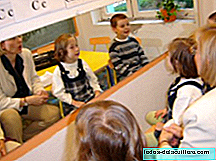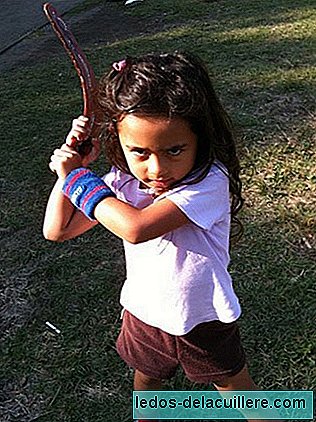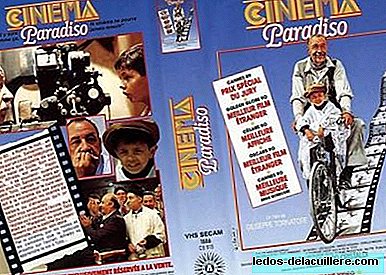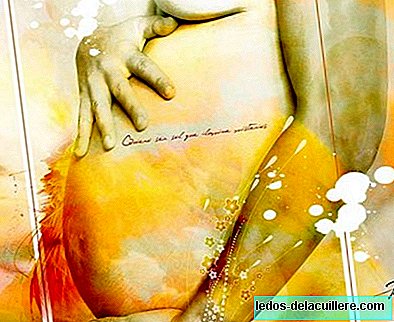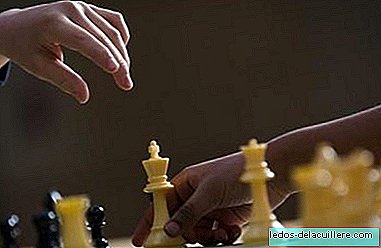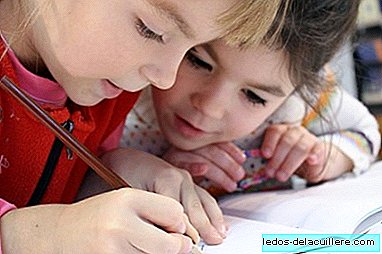
In recent studies we have been researching mirror writing in children aged four to six years. This term is used when characters (numbers and uppercase letters) they are inverted, but they are correct, as when they are reflected in a mirror.
In the case of normal writing, the mirror should be placed to the right or left, perpendicular to the horizontal plane of the writing. There may also be cases of writing in a vertical mirror, which can only be seen correctly if we look at the characters in a mirror located below or above.
At first glance one might think that children, who often sit face to face in the nursery, invest the characters because they see them in the folio of the child in front of them. However, this is not the case, because if it were, children would write double-inverted characters: both horizontally and vertically (see figure 1).
 Figure 1: French-style digits written in mirror (except 0 and 8). Assigned by the author
Figure 1: French-style digits written in mirror (except 0 and 8). Assigned by the author
 In Babies and more My son has a bad handwriting: what can be behind and how to improve it
In Babies and more My son has a bad handwriting: what can be behind and how to improve itThe origin of the mirror writing (particularly surprising when the letters are in italics and therefore together, as in the case of Joséphine in Figure 2) has been a mystery for a long time, but it can also be a bit disconcerting because children naturally reproduce ways of writing that they have never seen before and obviously have not learned.
The American linguist Noam Chomsky essentially used the idea that children produce phrases that they have never heard (or read, of course) to support the notion that language is innate. On the contrary, let's see how the horizontal mirror writing of the characters has a cultural explanation within the limitations imposed by brain processing.
 Mirror writing of his name by two right-handed children of five years and five months, and five years and seven months (spontaneously, but under some spatial limitations). Assigned by the author
Mirror writing of his name by two right-handed children of five years and five months, and five years and seven months (spontaneously, but under some spatial limitations). Assigned by the author
Mirror writing came into the world of research after an article by German neurologist Alfred Buchwald in 1878 (in German, mirror writing is called Spielschrift), but during the following 125 years the explanations for this phenomenon were not only insufficient, but also often erroneous.
One of the main reasons for the failure of explanations is that there was often a "culprit": write with your left hand. For a long time, this dominant discourse was supported by the observation of left-handed children who wrote characters, their names or even whole words and phrases backwards. Thus, throughout the twentieth century, scientific journals have published examples of mirror writing produced almost exclusively by left-handed children. Even today, being left-handed is often the teachers' favorite explanation when children write backwards.
Brain and behavioral components
The explanation we have found for the phenomenon of specular character writing works at two successive levels: the first is cerebral and the second is behavioral.
The brain level has long been limited to the simplistic theory made in 1925 by Samuel Orton in which one of the cerebral hemispheres (usually on the left) would correctly represent the letters while the other hemisphere would represent them as if they were reflected in a mirror.
However, more recently it has been shown that the brain eliminates orientation (left or right) when recording images, a process known as symmetry or mirror generalization. This generalization process, which can be very useful when recognizing a face from its left or right side, makes children learn the shape of the characters by heart, but not their left or right orientation.
Given the characteristics of the process (horizontal mirror in the visual mode) it is important to emphasize that the implicit initial learning of the shape of the characters in children is mainly visual and that there are practically only cases of writing in the horizontal mirror.
At the behavioral level, when children write the memory characters they have to give them an orientation. In countries whose main languages are written with Latin characters (written from left to right) children often point to the right. This makes mainly reverse left-oriented characters (J, Z, 1, 2, 3, 7, and 9) compared to other characters (see figure 3). However, when spatial limitations cause them to write from right to left, children reverse the right-oriented letters (see the case of letters E, N and C of MAXENCE in figure 2). This suggests that children usually orient the characters to the direction of their writing.
 Figure 3: Writing several characters by a right-handed child of six years and two months. Assigned by the author
Figure 3: Writing several characters by a right-handed child of six years and two months. Assigned by the author
 In Babies and more Why we should not force children to read before age six: their brain is not prepared Given that this explanation has nothing to do with whether children are left-handed or right-handed, we can assume that both they can write the characters in reverse, and that in western cultures children, whether left-handed or right-handed, will tend to reverse the characters oriented to the left.
In Babies and more Why we should not force children to read before age six: their brain is not prepared Given that this explanation has nothing to do with whether children are left-handed or right-handed, we can assume that both they can write the characters in reverse, and that in western cultures children, whether left-handed or right-handed, will tend to reverse the characters oriented to the left.This prediction was confirmed in a 2016 study, as well as another more subtle prediction: children who reverse left-oriented characters are also those who least invest right-oriented characters. This is due to the fact that only the characters are written inverted according to the direction of the writing.
Our explanation is based on an analysis of tens of thousands of writing examples of more than a thousand children published in different academic journals, particularly in the Journal of Educational Psychology. The theory remains relatively unknown, perhaps due to its recent appearance, and some parents continue to wonder if their children's mirror writing could be the precursor to a disorder such as dyslexia. Even some pediatricians or occupational therapists still do not give another answer that does not suggest that the child could be left-handed frustrated or have a bad lateralization, none of which is backed for our research on the typical development of a child.
Author: Jean-Paul Fischer, Professor Emeritus of Psychology, University of Lorraine.
This article has originally been published in The Conversation. You can read the original article here.
Translated by Silvestre Urbón


